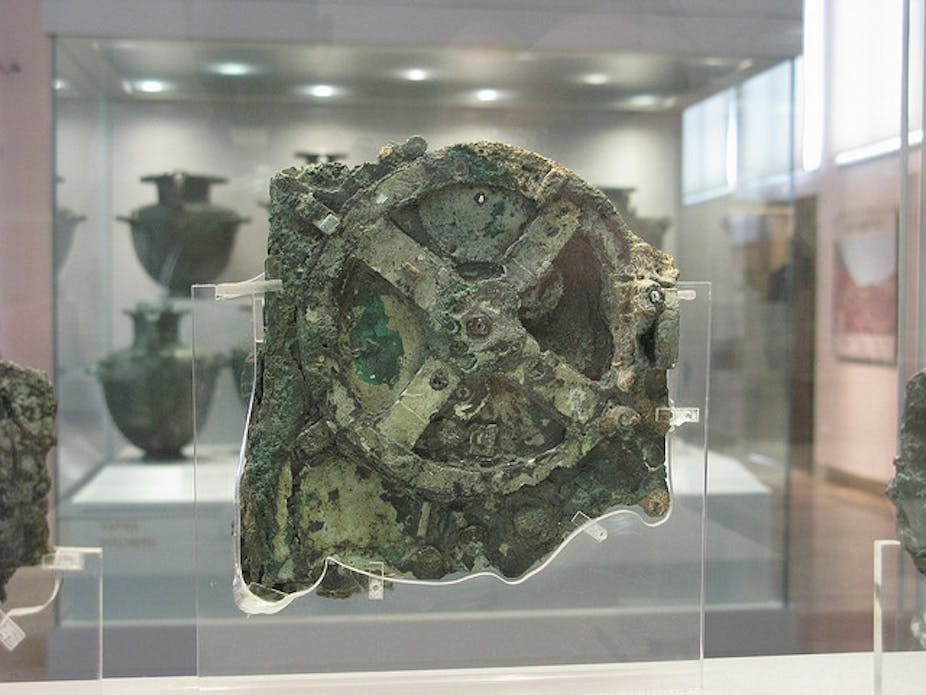Modern humans may think they are clever, and each generation typically thinks it’s more intelligent than those that came before. Hence, it can be a shock to discover civilisations existing thousands of years ago possessed highly advanced knowledge and technologies.
It’s fascinating to examine these examples, both from the point of view of the specific technologies and from a broader perspective. What motivates innovation in technology? How can different areas of science come together to foster innovation? And, what can history teach us on these points?
These were themes for a conference – From Antikythera to the Square Kilometre Array: Lessons from the Ancients – held recently in the small village of Kerastari, Arcadia, in the central Peloponese of Greece.
The Antiky-what-now?
The Antikythera mechanism is an astonishing Greek device that was lost for more than 2,000 years. It was retrieved in fragments from a shipwreck off the island of Antikythera in 1901.
The mechanism is dated to approximately 150 BCE and contains elaborate gear trains that have been demonstrated to predict lunar and solar eclipses and perhaps the movements of the five visible planets.
While some debate still exists regarding the exact purpose of the mechanism, it’s clear the knowledge and technologies involved in the production of the device were highly advanced, as discussed in a Nature paper in 2006. A number of attempts have been made at reconstructing the mechanism, based on interpretations of the fragments.
Below is a video of a 3D simulation of how the the mechanism may have worked.
Conceiving and manufacturing the Antikythera mechanism was obviously a significant undertaking, more than 2,000 years ago, involving astronomers and engineers.
Today, astronomers and engineers are teaming up again, seeking to push the boundaries of knowledge with an ambitious project to build a radio telescope to look back to the beginning of the universe - the Square Kilometre Array (SKA)).
Parallels of the ancient and modern
As with the Antikythera mechanism, the SKA will require innovations at the limits of current technology. The project will also require close collaboration with industry in areas of mass production, high performance computing, and advanced data networking.

The SKA has been covered extensively recently in The Conversation, following the big news that the SKA will be shared between the two sites who competed for hosting rights, Australia/New Zealand and South Africa.
So the recent conference in Greece was timely, asking questions such as: how does innovation arise? And how can we maximise the innovation potential in projects such as the SKA?
At the conference we heard from historians about the way in which the Antikythera device may have been conceived and produced, discussing parallels with modern practices of conceiving and implementing significant technology projects.
We heard from people who have deep experience in innovative technologies, including Professor John O'Sullivan and Professor David Skellen, both involved with the development of wireless networking.
We also explored the deep and surprising connections between the Antikythera mechanism and radio astronomy.
The fragments of the Antikythera mechanism are fragile and require special treatment and analysis. Critical to understanding the mechanism was computed tomography, revealing the structure of the mechanism encased within the corroded, encrusted fragments.
The video above shows results from computed tomography, which slices through the mechanism revealing the elaborate gear trains.
This type of tomography is very closely related to the MRI scans performed at hospitals. The image reconstruction and signal processing techniques used in tomographic imaging are very close cousins to the image reconstruction techniques used in radio astronomy, critical to the SKA.
This shows that cross-fertilisation can lead to advances in surprising areas. In his presentation, Professor John O'Sullivan characterised this as an effect of the combinatorial nature of innovation, where technologies combine and breed new ideas and applications.
So innovation is most likely to reside at the boundaries between disciplines, which offers us a pointer toward progress: get experts together from different fields, give them some challenging problems to think about, and don’t get in the way.
The Antikythera offers remarkable glimpses into the past – but also into ways we might work together in the future.
This article is dedicated to the _From Antikythera to the Square Kilometre Array: Lessons from the Ancients conference organiser, Dr Tasso Tzioumis, a collaborator of mine at CSIRO over the last 20 years – a man of boundless energy and enthusiasm._

